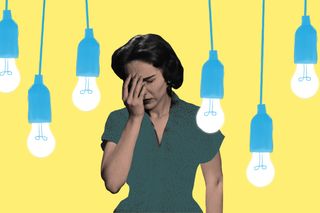
Is This Normal? ‘White Lights Make Me Anxious’
White light’s higher blue content can evoke feelings of alertness, exacerbating the stress and anxiety that one might already be feeling.

In this series, we dig into our strange phobias, fixations, and neuroses, and ask ourselves — Is This Normal?
I cannot stand white lights for some inexplicable reason. It’s often a bone of contention between my partner and myself — he prefers well-lit living areas while I fit into the stereotype of a vampire that prefers to lurk in the shadows. But while darkness is my personal favorite, I’ve made my peace with yellow lights — the dimmer the better, of course. Being in a space bathed in white light makes me anxious, and I simply can’t stop fixating upon its existence and get myself to relax instead; I’ve tried.
Is this normal?
“I don’t know if I’m the only crazy one, but I’ve always been bothered by artificial brightness, especially when it’s white. I’m much more pleased by background or warm lights,” wrote a Reddit user. Another chimed in: “I always thought I was weird for not liking the white lights in my [house] growing up. These days, I go out of my way to get lights with a yellow glow… [W]hite light is brighter, but I’d still [rather] have a softer yellow light over white any day.”
Evidently, then, I’m not alone in my crusade against white lights. It is, indeed, brighter than yellow lights — since “the filters used to create selective yellow light dim the brightness of headlights [while] white light is unfiltered, making it brighter.” And that’s probably the root of my aversion to it.
Related on The Swaddle:
Is This Normal? “Every Time I Start to Feel Happy, I Get Scared Bad Things Will Happen”
As an autistic individual with a pronounced sensory processing disorder, I am easily overwhelmed by sensory stimuli — be it loud music, strong smells, or the good old white lights. While research on the intersection of autism and photisensitivity is scarce, it’s not entirely non-existent. “[A]utistic individuals [may have an] abnormal pupillary light reflex, which refers to how the pupil reacts and adapts to the brightness of various light sources. Photosensitive retinal ganglion cells — which have been implicated inmigraine-related light sensitivity — are central in this process, thus suggesting that impairment may similarly affect how autistic persons perceive light,” explains an article.
Delving deeper, it notes that autistic individuals “have also been found to have physical differences in the structures of their central nervous systems [and] there is evidence that they also have a lower neurological threshold for environmental stimuli, including light.”
But that doesn’t automatically mean that everyone who can’t stand white lights is autistic. Interior decorators frequently do up home spaces with yellow lights, and office and industrial spaces with white. It has to do with the former being more relaxing — because it contains less blue light.
Blue light, indeed, can induce stress. Research suggests that being exposed to bright, blue lights — compared to dimmer, red lights — increases the level of cortisol, or the stress hormone, in our bodies. Researchers also note that, as a result, blue light can impact our emotions, making us feel irritable and fatigued. In fact, it is reported that “super bright, long cylinder lights can promote anxiety attacks with those people with generalized anxiety disorder.”
Related on The Swaddle:
Is This Normal? “I Can Only Sleep If I’m Covered With A Blanket”
Conversely, the presence of blue hues in white lights also makes some people more productive: “White light makes me feel more productive and motivated to do tasks… Meanwhile, warm light seems very cozy, but it also keeps me lazy, makes me want to go to bed, and not do anything anymore,” an individual said online.
Basically, white light’s higher blue content can evoke feelings of alertness and attention. But, at the same time, it may also exacerbate one’s stress and anxiety. On the other hand, yellow light — or warm white light — is reminiscent of sunsets and candlelight, creating a cozy and relaxing atmosphere, and inducing a sense of comfort and calm.
But because white lights are often present at workplaces and classrooms — environments that one might associate with stress — having white lights in our living areas at home can induce a sense of unease, leaving one feeling disconcerted.
Well, at least, now I have some research to present to my partner the next time we argue about white lights. And, of course, the knowledge that I’m not alone helps, too.
Devrupa Rakshit is an Associate Editor at The Swaddle. She is a lawyer by education, a poet by accident, a painter by shaukh, and autistic by birth. You can find her on Instagram @devruparakshit.
Related


Woe Is Me! “My Partner Is a Workaholic. Should I Get Over It?”
